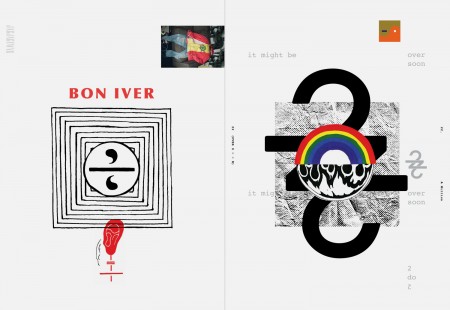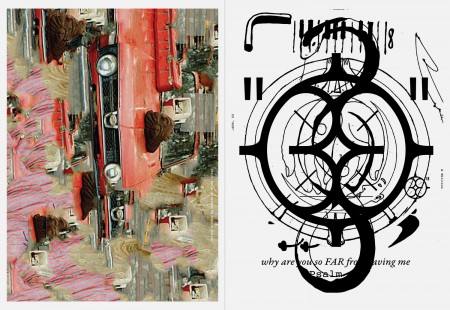When Bon Iver released 22, A Million, in September of 2016, I heard the album before I saw it. We were in the car, my three friends and I, on our way back to LA after a weekend camping in Alabama Hills. Kelsey was on the aux and she told us only that Bon Iver had released a new album and that it was “totally experimental, like way different than his old stuff.” We listened to all ten tracks straight through, entranced by the meticulous blending of airy saxophone notes dancing atop deep electronic beats that blared with intensified bass, reverberating within our bones but then melting into careful melodies that were sometimes soft, sometimes passionate, but always wonderfully cryptic.
So I didn’t see the album cover, didn’t read the song titles, had no idea the vast and complex system of semiotics, numbers and typography at play. I knew only from the sound of the work that this was something different. Gone were the woodsy, soft, Americana mountain songs and folk acoustics of the Justin Vernon from For Emma, Forever Ago and Bon Iver. While I wasn’t yet sure what this album was, I knew only that it was something new, something digitized and deeply layered and abstract and beautiful and boundless.
After countless hours spent further listening and exploring this album, I’ve compiled a list of the top ten moments that make 22, A Million a rich and mystified compilation of music, poetry, technology and artistic experimentation unlike any other.
Eric Timothy Carlson is the artist behind the visually stunning symbolism and numerology comprising the project’s artwork, which exists not only on the album cover itself but also in other forms such as lyric videos and giant murals created to coincide with the album’s release. In interviews, Carlson explains that each song was given a number, as reflected in the song’s title. These numbers Carlson then paired with individual rune-like symbols that have their own unique personal meaning, anecdotal history and cultural association. The symbols build off of one another, culminating in a shared collection of hundreds of designs, icons, sketches, patterns, ideas and motifs that have all been carefully crafted to produce a visual component to the album which, as Carlson described in a previous interview, “is something of a tome. A book of lore. A lost religion. Something that presents a lot of unanswered questions and wrong ways. A distant past and future. An inner journey somehow very contemporary.” The album packaging comes with a master legend of all of the symbols, providing the consumer with the opportunity to unpuzzle, interpret and reflect. It is through this imaginative use of semiotics that together Carlson and Vernon have created something that goes beyond the world of just music and bleeds into other realms of the textual, the visual and the digital.


2. The "715 - CR∑∑KS" Official Lyric video
“715 – CR∑∑KS,” with it’s fully electronic and auto-tuned sound, is the digital apex of this album’s futuristic aesthetic. The lyric video itself is a demonstration of this, providing the viewer with an image of a computer screen upon which the lyrics are typed out in time with the music. In the same way Vernon’s auto-tuned voice frequently fluctuates, often faltering and catching at unexpected intervals, there are a number of “glitches” where the lyrics are either spelled incorrectly or symbols are rapidly typed in nonsensical order and then erased. This lyric video presents a digital vision of the future that still maintains a messy quality, capturing the imperfections of humanity and the limits of technology. The electronic world we are given, while undeniably beautiful and characteristically profound, is still filled with a number of bugs that have yet to be worked out. Additionally, the concept of the lyric videos themselves are transformative in that they make the audible visible, providing a textual element that deeply enhances the music. Through the use of semiotics and the transcription of lyrics, the words become poetry and the songs become texts, breaking down barriers and opening up space for an entire new realm of interpretation.
3. 1:01 on “22 (OVER S∞∞N)”
“THERE ISN’T CEILING IN OUR GARDEN”
From the first song on the album, Vernon sets a tone of impermanence with the single repeated line: “It might be over soon.” Yet despite this beginning which continually references an impending end, the hymn-like, gospel tones are not of sadness, pessimism or fear, but of hope. The line “there isn’t ceiling in our garden,” puts into words an idea encapsulated by this project in its totality: what is now is temporary, and with it’s end comes room for future growth.
4. 2:12 on "666t"
“TAKE ME INTO YOUR PALMS / WHAT IS LEFT WHEN UNHUNGRY”
This song is extremely obscure in lyrical nature yet maintains a repetitive, syncopated electronic rhythm that consists of four beats and runs throughout the entire duration of the song. Like a digital metronome, this beat grounds the listener as the lyrics drift off towards complex spiritual questions of divinity and self-reflection. This song is particularly interesting in relation to Carlson’s idea of the album’s use of semiotics and numerology to foster “a lost religion,” in that the lyrics focus heavily on spiritual themes of prayer. Visually, the track’s title consists of the devil’s number and an upside down cross. The most effective aspect of this song is its refusal to provide answers. This song offers nothing but a space for interpretation and self-reflection as it not only asks about the nature of religion, but rather the future of religion and the possible aftermath and effects. We often only speak about the search for enlightenment and fulfillment, but what is left when unhungry? What comes next?
5. 4:05 on “8 (Circle)”
“ I WILL RUN ALL AROUND IT / HAVE TO CRAWL / STILL CAN’T STOP IT”
“SAILING OFF AND ON YOUR HONOR / CARRY OFF + UP YOUR SEIZE / ALONG THE FIRES”
“FROM THE CORE TO THE SKY / FROM THE DOOR TILL WE DIE / CARRY UP LOVE ALONG UNFETTERED TIME”
In the final minute of this song, Vernon overlays three verses atop one another simultaneously. In doing so, he blends intersecting storylines that hit the listener with an amassed weight of lyrical depth and raw emotion. For the first four minutes of this song, a soft beat runs steadily in the background. At 4:05, however, the beat drops out and the horns grow louder as the listener basks in this enormous crescendo of multilayered harmonious glory.
6. 1:01 on "29 #Strafford APTS"
“A WOMB / AN EMPTY ROBE / ENOUGH / YOU’RE ROLLING UP / YOU’RE HOLDING IT / YOU’RE FABRIC NOW”
The strong acoustics in this piece cause “29 #Strafford APTS” to more closely resemble Vernon’s past work more so than any of the other songs on the album. The melodies are soft and soothing, complementing the nostalgic tone of the lyrics while musically the piece contains a number of rises and dips that are reminiscent of a lullaby. This piece reminds us that as we move forward and stride towards a future built on progress, whether we intend it or not, the changes we make continue to hold roots in our pasts.
7. 1:35 on "____45_____"
“WELL I BEEN CAUGHT IN A FIRE”
Lyrically, this piece is bare bones. The repeated phrase “Well I been caught in a fire” is the only line sung for the first minute and a half of the song. In repeating this phrase over and over again, Vernon plays with variation. He extracts everything he can from each note and each letter, experimenting and toying with all the possibilities he is capable of producing. Meanwhile, in the background the horns continually crescendo, rising and growing louder until the song finally ends in a brilliant eruption of symphonic bliss. In short this is a piece about play and possibility.
8. 1:12 on "10 d E A T h b R E a s T"
“FUCKIFIED / DARLING MAKE LOVE DON’T FIGHT IT”
This piece is the heaviest with regards to its electronic beats and pulsing rhythm. The listener is hit with a deep continuous beating that sounds like something is being punched over and over again. The word “deafening” rings out, sounding ethereal and out of place among the dark techno thuds that comprise this song’s base. There’s a release of tension as the electronic beats finally drop out. A pause ensues, providing almost a sense of relief. Vernon’s auto-tuned voice sings “Darling make love don’t fight it,” before the convulsing beat picks up again, pulling the listener back under and ensnaring him or her once more in an underworld of heavy, pulsating beats.
9. 2:09 ON "33 "GOD""
“I DIDN’T NEED YOU THAT NIGHT / I DIDN’T NEED YOU ANY TIME / JUST GONNA TAKE IT AS IT GOES / I COULD GO FORWARD IN THE LIGHT”
The pressing lyrics in this piece speak for themselves as we are offered a chilling performance of vulnerability and pain. Passion seeps from Vernon’s voice. The emotion is truly palpable.
10. 1:01 on "00000 million"
“THE DAYS HAVE NO NUMBERS”
In the final line of an album in which every song is a number and every number is a symbol, this line emphasizes the central point of this project: the semiotic system Carlson generated for the artwork of 22, A Million is not a rigid, defined code, but rather a language. The numbers are not meant to be individually dissected, but rather added together, subtracted from another and interpreted in combination with each other so as to work towards a productive space of imaginative creation and thought. 22, A Million presents one with a legend and symbols, offering a language intended to be used to start dialogues, ask questions, and foster communication, interaction and collaboration not only among the various forms of music, poetry, art, technology and media, but also among the individuals who consume them.
SOURCES:
https://walkerart.org/magazine/designing-bon-iver-22-a-million-album-art-eric-timothy-carlson?utm_content=buffer198bb&utm_medium=social&utm_source=twitter.com&utm_campaign=buffer



